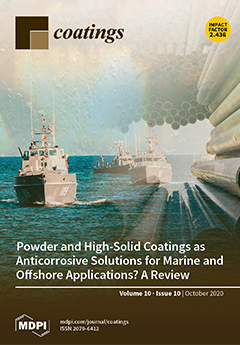Peri-implantitis, often induced by oral pathogens, is one of the main reasons for the clinical failure of dental implants. The aim of this study was to investigate the biocompatibility, osteogeneic, and antibacterial properties of a cerium oxide (CeO
2) coating containing high
[...] Read more.
Peri-implantitis, often induced by oral pathogens, is one of the main reasons for the clinical failure of dental implants. The aim of this study was to investigate the biocompatibility, osteogeneic, and antibacterial properties of a cerium oxide (CeO
2) coating containing high proportions of Ce
4+ valences on a titanium-based dental implant biomaterial, Ti-6Al-4V. MC3T3-E1 cells or bone marrow stem cells (BMSCs) were seeded onto Ti-6Al-4V disks with or without CeO
2 coating. Compared to the control, the plasma-sprayed CeO
2 coating showed enhanced cell viability based on cell counting kit-8 (CCK-8) and flow cytometry assays. CCK-8, colony-forming unit test (CFU), and live-dead staining illustrated the antibacterial activity of CeO
2 coating. Additionally, CeO
2 coating upregulated the gene expression levels of osteogenic markers
ALP,
Bsp and
Ocn, with a similar increase in protein expression levels of OCN and Smad 1 in both MC3T3-E1 cells and BMSCs. More importantly, the viability and proliferation of
Enterococcus faecalis,
Prevotella intermedia, and
Porphyromonas gingivalis were significantly decreased on the CeO
2-coated Ti-6Al-4V surfaces compared to non-treated Ti-6Al-4V. In conclusion, the plasma-sprayed CeO
2 coating on the surface of Ti-6Al-4V exhibited strong biocompatibility, antibacterial, and osteogenic characteristics, with potential for usage in coated dental implant biomaterials for prevention of peri-implantitis.
Full article





